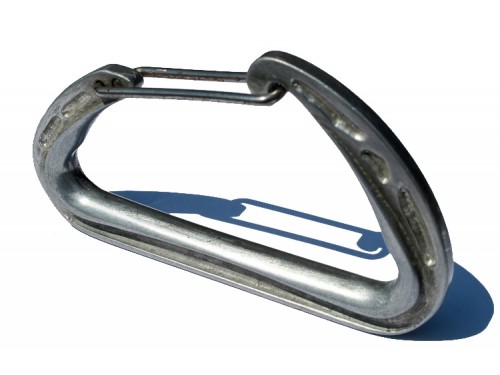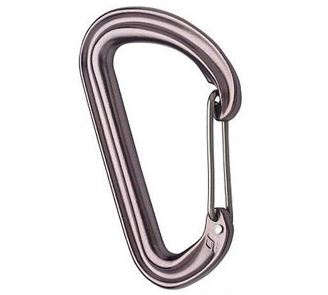HotWire History
I recently saw that Outside Magazine had voted the HotWire carabiner as one of the most influential pieces of gear of all time, which was a delayed honor as I designed the HotWire 18 years ago when I was working at Black Diamond Equipment. I first started working at BD right after they had broken off from Patagonia/Chouinard Equipment as a result of selling them my design for a three pointed climbing hook called the Talon. At the time, BD had less than 40 employees and a big selling point to hiring me was that I could not only provide my own Compaq 386 computer, but also had a legal copy of AutoCAD. My first official project was a redesign of the Talon, followed by a slight redesign of the Quicksilver carabiner. After that, we started on a whole new carabiner whose entire product brief was something along the lines of “make a really cool, super strong, lightweight sport climbing carabiner.”
Having grown up sailing in Seattle with my dad, I was familiar with wire gate carabiners as they’re very common in the maritime industry, so when it came to the “lightweight” part of the product description, this seemed obvious. The first prototype I made of the wiregate carabiner involved hand bending a piece of “piano wire” from a hobby store and milling the body out from a solid billet of some exotic military grade mystery metal that a supplier had sent us. I printed out drawings of the design and spray mounted them to the metal as a template for cutting and remember going through about 50 endmills as the material was so gummy and unmachinable.

HotWire Prototype #001 circa 1994
Between the crude prototyping and horrible gate action, this first prototype was greeted with almost universal disdain by everyone except Johnny Woodward. Johnny was also a Designer at BD, as well as having a background in math and being an incredible climber. At the time, the hallmark of BD carabiners was that the gate action was “as smooth as a BMW’s transmission” and Johnny was the guy who actually dissected the pivot points and geometry of the wire gate to understand why it worked and how to optimize it. He also realized that with less mass, a wiregate biner wouldn’t be as susceptible to gate whiplash, which can lead to carabiners being loaded in the “open gate” mode, which can reduce their strength from 25kN to 7kN. To prove this, Johnny mounted carabiners on a pivot and used high-speed photography to show beyond a doubt that a wiregate closed in a fraction of the time that it took a standard gate to retract.

A classic photo of Johnny Woodward on “Beau Geste.”
The wiregate idea was dropped from the immediate carabiner design, which eventually turned into Black Diamond’s first hot forged carabiner, The Fin. The Fin was intended as a sport climbing specific biner, but after it was introduced it became obvious that it had been designed and tested by people with large hands and was ridiculously oversized. It died a fairly quick death, but the namesake “fin” on the back spine eventually resurfaced on the LiveWire biner years later.

The short-lived “Fin” carabiner – so large you could fly a Space Shuttle through it.
Meanwhile, Johnny was still interested in the wiregate concept and it was decided that if we were going to make a wiregate biner, it needed to have its own body as the tail sections of existing biners was too small to house two holes. This was the official start of the HotWire biner and it took roughly a full year and 15 prototypes to dial in these two simple parts – the body and the gate.
Even after all the weights, strengths, functions, manufacturing and price issues had been resolved, there was still a large degree of skepticism about the biner and it was commonly referred to as “the paperclip gate” as it looked so weird. I distinctly remember the disappointment of hearing the pre-sales projection numbers before the HotWire was introduced as they were a tiny fraction of the numbers for the best selling Ovals, Light D’s and Quicksilvers. It was almost seen as a novelty biner with a host of unforeseen issues, like ropes being cut when it was cross-loaded (unfounded), gates losing their action or worst of all, general rejection by climbers.
Instead, what happened was that experienced climbers started using a few of them and realized that wiregate made an Aid rack lighter, they didn’t jam in the snow for alpine climbing, they were easier to clip for sport climbing, and best of all, there were no cut ropes or widespread failures. After that, the wiregate concept basically sold itself.

The modern day HotWire carabiner, which has been through a few redesigns since the mid 90’s.
For the first few years the HotWire had a “Pat. Pending” stamp on it, which was a crafty move on BD’s part. While wiregates may have been new to climbing, as other carabiner manufacturers pointed out, they were hardly a new invention, so how could they be patented? Good question, but is it worth sinking a bunch of time, effort and money into a project knowing that you might be infringing on a patent? Considering that the patent process can take years, especially if the applicants want it to, and gearing up to design and make a wiregate from scratch could take years, there were no other wiregates on the market for many seasons. The patent itself turned out to be on the riveting process for the two ends of the gate, and although I don’t know if it was ever granted, it served its purpose of holding off the competition, at least for a little while.
________________________________
Help support StraightChuter.com and get the new & improved Black Diamond HotWire Carabiner ON SALE NOW from Backcountry.com. Click on the photo below…
Category: Gear Reviews










Great read.
Awesome history! Thanks for the contributions.
hot wires mean I can eat more hot cakes!
i think the best part of this story was the whole IP law story in the last paragraph. very well done, that makes for a fantastic case
Thats so cool the way BD tried to scam the rest of the climbing industry and inhibit the development of safety gear. Way to go!
Nice job, Andrew. After helping to create so many amazing products over the years, why did you stop designing?
is it perhaps that designing distracts from skiing? :-)
Who among us, other than maybe accountants, lawyers and politicians, would work a real job if they didn’t have to? Good job Andrew, for your designs and figuring out how to get a real life.
Hi Hal – I haven’t stopped, I just happened to get sidetracked for a little while. I’ll be back. :)
Hmmm, I don’t know about that JEd. There were 100’s of other perfectly safe carabiners out there when the HotWire came out, and as I mentioned in the article, BD did invest over a year of time, effort and money into the development of the product. Once the gates were open (so to speak) pretty much every manufacturer started making reverse engineered wiregate biners.